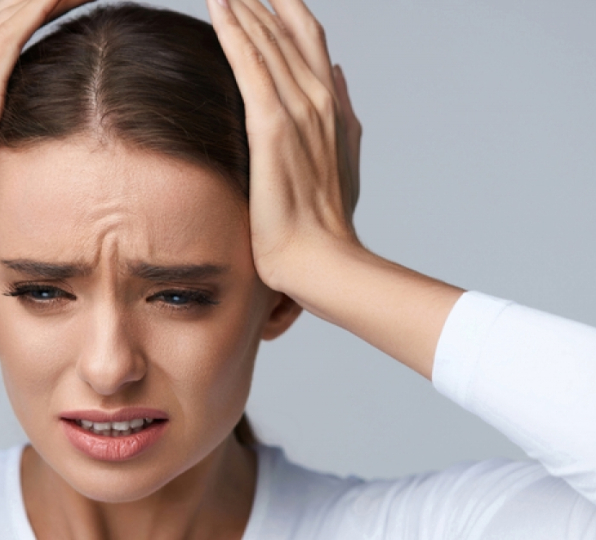Introduction:
Headaches are a common health issue that millions of people around the world deal with. Even though headaches are frequently treated like a common illness, effective management and prevention require knowledge of the underlying causes of headaches. We’ll explore the different causes of headaches in this blog post, from underlying medical conditions to lifestyle choices.
1. Types of Headaches
Headaches are a common ailment that can vary in intensity, duration, and underlying causes. Understanding the different types of headaches can help individuals identify their symptoms and seek appropriate treatment. Here are four common types of headaches:
- Tension Headaches: Tension headaches are the most common type of headache experienced by people worldwide. These headaches are characterized by a dull, aching sensation that typically affects both sides of the head. Tension headaches may feel like a tight band or pressure around the forehead, temples, or back of the head. They are often triggered by stress, anxiety, poor posture, muscle tension in the neck and shoulders, or eye strain from prolonged screen time. While tension headaches are usually not severe, they can be persistent and interfere with daily activities.
- Migraines: Migraines are severe, throbbing headaches that can be debilitating for those who experience them. Unlike tension headaches, migraines often affect only one side of the head and are accompanied by additional symptoms such as nausea, vomiting, sensitivity to light (photophobia), and sound (phonophobia). Some individuals may also experience visual disturbances known as auras, which can include flashing lights, blind spots, or zigzag lines in their field of vision. Migraines can last for hours or even days and may be triggered by various factors, including hormonal changes, certain foods or drinks, environmental factors, and stress.
- Cluster Headaches: Cluster headaches are intensely painful headaches that occur in clusters or cyclical patterns, typically lasting between 15 minutes to three hours. These headaches often occur on one side of the head, usually around the eye or temple, and may be accompanied by symptoms such as tearing of the eyes, nasal congestion, or drooping eyelids. Cluster headaches tend to occur suddenly and frequently, with individuals experiencing multiple attacks per day during a cluster period. While the exact cause of cluster headaches is unknown, they are believed to be related to abnormalities in the hypothalamus and may be triggered by certain factors such as alcohol consumption or changes in sleep patterns.
- Sinus Headaches: Sinus headaches occur when the sinuses become inflamed or congested due to allergies, infections, or other factors. These headaches are often accompanied by symptoms such as facial pressure, pain or tenderness around the cheeks, forehead, or nose, and nasal congestion or discharge. Sinus headaches may worsen with changes in head position, such as bending forward or lying down, and may be accompanied by other sinus-related symptoms such as coughing, sneezing, or fever. It’s essential to differentiate between sinus headaches and other types of headaches, as sinus headaches may require specific treatments such as decongestants or antibiotics if caused by a bacterial infection.
2. Common Causes of Headaches
- Stress and Tension: Emotional stress and physical tension can lead to muscle contractions in the head and neck, triggering tension headaches.
- Poor Posture: Prolonged periods of sitting or standing with poor posture can strain the muscles in the neck and shoulders, contributing to tension headaches.
- Dehydration: Inadequate hydration can lead to dehydration, which is a common trigger for headaches.
- Lack of Sleep: Sleep deprivation can disrupt normal brain function and trigger headaches in susceptible individuals.
- Eye Strain: Prolonged use of digital devices or reading in poor lighting conditions can strain the eyes and lead to headaches.
- Dietary Factors: Certain foods and beverages, such as alcohol, caffeine, processed foods, and artificial sweeteners, may trigger headaches in some people.
- Hormonal Changes: Fluctuations in hormone levels, particularly in women during menstruation, pregnancy, or menopause, can trigger migraines.
- Environmental Factors: Exposure to strong odors, loud noises, or changes in weather patterns can trigger headaches in sensitive individuals.
- Medications: Some medications, including certain antidepressants, birth control pills, and blood pressure medications, may trigger headaches as a side effect.
- Underlying Health Conditions: Headaches can also be a symptom of underlying health issues such as sinus infections, head injuries, brain tumors, or neurological disorders.
3.Identifying Personal Triggers
Identifying personal triggers for headaches is a proactive step towards managing and potentially alleviating their frequency and severity. One effective method to pinpoint triggers is by maintaining a headache diary, where individuals meticulously record details surrounding each headache episode. This diary serves as a valuable tool for tracking patterns over time and identifying potential triggers that may contribute to the onset of headaches.
In a headache diary, individuals can log various factors such as the date and time of each headache episode, the duration and intensity of the headache, any accompanying symptoms, and specific circumstances or activities leading up to the onset of the headache. By consistently documenting this information, patterns and trends may emerge, providing insight into potential triggers.
One crucial aspect of maintaining a headache diary is paying close attention to lifestyle habits, dietary choices, and environmental factors that coincide with headache episodes. For example, individuals may notice that certain foods or beverages, such as aged cheeses, processed meats, alcohol, or caffeine, tend to trigger headaches. Additionally, environmental factors like exposure to bright lights, strong odors, or changes in weather conditions could also play a role in triggering headaches for some individuals.
In addition to dietary and environmental factors, lifestyle habits such as irregular sleep patterns, high stress levels, excessive screen time, or skipping meals may contribute to the occurrence of headaches. By documenting these habits alongside headache episodes in the diary, individuals can identify potential correlations and make informed adjustments to their routines to mitigate triggers.
While self-tracking and awareness are valuable tools in identifying personal triggers for headaches, it’s essential to recognize when to seek medical evaluation, especially for recurrent or severe headaches. Consulting a healthcare professional can help rule out underlying health conditions that may be contributing to the headaches and provide personalized guidance on management and treatment options.
In summary, identifying personal triggers for headaches involves maintaining a detailed headache diary to track patterns and correlate episodes with specific factors such as lifestyle habits, dietary choices, and environmental influences. This proactive approach empowers individuals to gain insight into their headache triggers and make targeted lifestyle modifications to reduce their frequency and severity. However, it’s essential to seek medical evaluation for persistent or severe headaches to ensure proper diagnosis and management.


Conclusion:
Understanding the diverse causes of headaches is the first step toward effective management and prevention. By identifying personal triggers and adopting healthy lifestyle habits, individuals can reduce the frequency and severity of headaches. However, it’s essential to seek medical evaluation for persistent or severe headaches to rule out underlying health issues and receive appropriate treatment. With proactive management and support, individuals can alleviate the burden of headaches and improve their overall quality of life.












